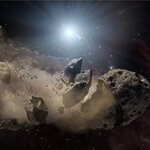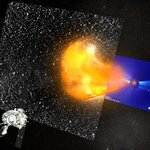Space

Astronomers using the United Kingdom Infrared Telescope (UKIRT) in Hawaii, the IRAM Millimetre-wave Telescope in Spain, and the Spitzer Space Telescope in orbit above the Earth, have completed the most wide-ranging census ever produced of dynamical star formation in and around the well-known Great Nebula of Orion.
They have found this stellar nursery to be a lively and somewhat overcrowded place, with young stars emitting gas jets in all directions, creating quite a chaotic picture and demonstrating there is much more going on in Orion than previously thought. Researchers including UKIRT…

An international team have discovered one of the coolest sub-stellar bodies ever found outside our own solar system, orbiting the red dwarf star Wolf 940, some 40 light years from Earth.
The object is thought to have formed like a star, but has ended up looking more like Jupiter. It is roughly the same size, despite being between 20 and 30 times as heavy, and when the infrared spectral "fingerprints" of the two objects are compared, their resemblance is striking.
The new object orbits its star at about 440 times the distance at which the Earth orbits the sun. At such a wide distance,…

'Sigmoids' are S-shaped structures found in the outer atmosphere of the Sun (the corona), seen with X-ray telescopes and thought to be a crucial part of explosive events like solar flares. Now a group of astronomers have developed the first model to reproduce and explain the nature of the different stages of a sigmoid’s life.
Recently, the X-Ray Telescope (XRT) on board the Hinode space mission was used to obtain the first images of the formation and eruption phase of a sigmoid at high resolution. These observations revealed that the structure of the sigmoid is complex: it consists of many,…

Using NASA’s Spitzer Space Telescope, an international team of astronomers have found that at least 1 in 100 white dwarf stars show evidence of orbiting asteroids and rocky planets, suggesting these objects once hosted Solar Systems similar to our own. Team member Dr Jay Farihi of the University of Leicester will present this discovery on Monday 20th April at the European Week of Astronomy and Space Science conference at the University of Hertfordshire.
White dwarf stars are the compact, hot remnants left behind when stars like our Sun reach the end of their lives. Their atmospheres should…

Astronomers have announced plans to build an ultra-stable, high-precision spectrograph for the Science and Technology Facilities Council's 4.2-m William Herschel Telescope (WHT - part of the Isaac Newton Group or ING on La Palma) in an effort to discover habitable Earth-like planets around other stars. Dr Ian Skillen of the ING will present the new High Accuracy Radial-velocity Planet Search – New Earths Facility (HARPS-NEF) spectrograph in a poster on Monday 20th April at the European Week of Astronomy and Space Science conference at the University of Hertfordshire.
Spectrographs analyse the…
Kepler has First Light. It is On! Team is a Go! Photons are Arriving!
This provocativly-titled NASA release states "NASA's Kepler Captures First Views of Planet-Hunting Territory", and has a good explanation of Kepler's capabilities. What I wish to tackle is why Kepler matters.
Kepler is a new space telescope with an awesomely wide field of view, seeing a huge 100 square degrees in a single frame, then zooming in closer with two other 'scopes. It is primarily a planet-hunting mission, but there will be much good science coming from Kepler-- some of which we can't even imagine yet.
Kepler…

The most crowded collision of galaxy clusters has been identified by combining information from three different telescopes. This result gives scientists a chance to learn what happens when some of the largest objects in the Universe go at each other in a cosmic free-for-all.
Using data from NASA's Chandra X-ray Observatory, Hubble Space Telescope and the Keck Observatory on Mauna Kea, Hawaii, astronomers were able to determine the three-dimensional geometry and motion in the system MACSJ0717.5+3745 (or MACSJ0717 for short) located about 5.4 billion light years from Earth.
The researchers…

If you happened to visit this site earlier today, you may have found it devoid of a suitable banner. That is because I took some time pondering on that design detail for this new site. I wanted something that resembled the banner of the old site which hosted my blog, over at wordpress, which showed a starry field; but I also wanted to convey some personality with it -no more anonymous pictures stolen from a prepackaged theme (Regulus in that case); and possibly, some meaning.
In the end, my choice has fallen on the picture clip you can see above. This picture is dear to me, because it was a…

Given my title, I believe this is my first official rant. NASA ran a press conference on STEREO today. As the First 3D Reconstruction of a CME, it... okay, let me pause here. There have been 3D reconstructions of CMEs since the SOHO era. And there are at least 7 papers in the literature using some variant of the words 'First STEREO reconstruction of a CME'.
I should have titled my recent paper "Second STEREO reconstruction of a CME" to distinguish it. Putting "First" in an academic title is too similar to the memetic 'Frist Post' on a web forum. Anyone can be first if they define it…

Twin NASA spacecraft have provided scientists with a view of the speed, trajectory, and three-dimensional shape of powerful explosions from the sun known as coronal mass ejections, or CMEs. This new capability will dramatically enhance scientists' ability to predict if and how these solar tsunamis could affect Earth.
When directed toward our planet, these ejections can be breathtakingly beautiful and yet potentially cause damaging effects worldwide. The brightly colored phenomena known as auroras -- more commonly called Northern or Southern Lights -- are examples of Earth's upper atmosphere…